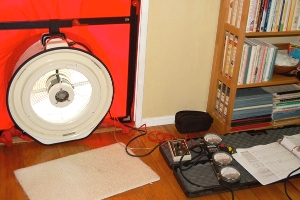 A blower door is used to see how leaky a home is by depressurizing it. Image courtesy of Jim Gunshinan.
A blower door is used to see how leaky a home is by depressurizing it. Image courtesy of Jim Gunshinan.
In a recent blog post, I wrote about what it takes to become certified as a Building Analyst through the Building Performance Institute (BPI) (“Am I certifiable?”). A BPI certification or becoming a certified HERS (home energy rating system) rater through the Residential Energy Services Network (RESNET) are the most recognized ways to enter the home performance marketplace.
But in several blogs I read on a regular basis and in conversations with building analysts and HERS raters, I’ve found a lot of frustration, even anger, at the slow pace of the economic recovery. Here’s a typical response: “I bought the tools and put time and money into training, but where are the jobs? ” Being certified as a Building Analyst will no doubt make me a better writer and editor. But for thousands of men and women, being certified and finding work in the home performance field is a matter of economic survival.
The problem right now is financing. Who has the money to spend on a home energy upgrade nowadays? The costs can run anywhere from about $2,000 to over $10,000. Municipal governments all over the country are experimenting with financing mechanisms for home energy retrofits—the city pays for the retrofits and recovers its costs through an increase in property taxes, for example. The city of Babylon, New York, charges building owners a tax on carbon emissions, and uses this as seed money to do retrofits. But all these efforts so far have not brought about the expected increase in “green jobs”.
This may soon change. Heard of the “Cash for Caulkers” program? This is the nickname for HOME STAR, a program to provide incentives for homeowners to upgrade their homes to be more energy efficient, healthy, and affordable to live in. The program was born in the minds of private sector advisors, including the Silicon Valley venture capitalist John Doerr; members of Efficiency First, a national advocacy group started in the Bay Area; and others. On November 2, the group presented its ideas at a meeting of the Presidents Economic Recovery Advisory Board. Word on the street is that the plan has the support of the President.
